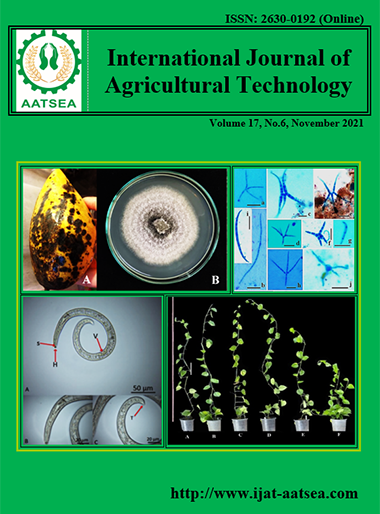Yield stability of new elite lines of yardlong bean (Vigna unguiculata (L.) Walp. subsp. sesquipedalis Verdc.)
Main Article Content
Abstract
The yield trials of new elite lines of yardlong bean under nine environments revealed that they differently responded to multi-environments for horticultural traits and yield. Genotype-environment interactions were significantly found (P < 0.01) for the days of anthesis, pod length, seeds per pod, pod weight and yield per hectare. Significant differences (P < 0.01) of yield were observed for genotypes, environments, and genotype-environment interaction. Stability analysis after Eberhart and Russell’s model suggested that non-linear component was more important than linear component for determining the yield stability. Based on stability parameters, line No.30 was identified as stable for yield since it gave high yield (14.17 t/ha), high positive phenotypic index (Pi > 0), regression coefficient around unity (bi = 1), and deviation from regression value around zero ( = 0). Bangpra2 and No.25 lines also gave high yield but their deviations from regression were highly significant, it clearly shown that these 2 lines were unpredictable expected by linear regression. However, considering their yields from various environments, they were suitable for highly favorable environments but under poor environments. Environmental index which directly reflected the poor and rich environment in terms of negative and positive of yield revealed that environments 1 and 2 were rich environments, and environments 6 and 9 were poor environments.
Article Details

This work is licensed under a Creative Commons Attribution-NonCommercial-NoDerivatives 4.0 International License.
References
Akcura, M., Kaya, Y. and Taner, S. (2005). Genotype-environment interaction and phenotypic stability analysis for grain yield of durum wheat in Central Anatolian Region. Turkish Journal of Agriculture and Forestry, 29:369-375.
Arshad, M., Bakhsh, A. Haqqani, M. and Bashir, M. (2003). Genotype-environment interaction for grain yield in chickpea (Cicer arietinum L.) Pakistan Journal of Botany, 35:181-186.
Becker, H. C. and Leon, J. (1988). Stability analysis in Plant Breeding. Plant Breeding, 101:1-23.
Deitos A., Arnhold, E. and Miranda G. V. (2006). Yield and combining ability of maize cultivars under different ecogeographic conditions. Crop Breeding and Applied Biotechnology, 6:222-227.
Department of Agricultural Extension (2018). Information technology system for agricultural production. Retrived from http://production.doae.go.th/report/report_main2.php?report.
Eberhart, S. A. and Russell, W. A. (1966). Stability parameters for comparing varieties. Crop Science, 6:36-40.
Hebert, Y., Plomion, C. and Harzic, N. 1995. Genotypic x environment interaction for root traits in maize as analyzed with factorial regression models. Euphitica, 81:85-92.
Little, T. M. and Hills, F. J. (1978). Agricultural Experimentation Design and Analysis. John Wiley & Sons, Inc. Canada.
McIntosh, M. S. (1983). Analysis of combined experiments. Agronomy Journal, 75:153-155.
Moldovan, V., Moldovan, M. and Kadar, R. (2003). Yield stability and breeding for adaptation in winter wheat. Annual Wheat Newsletter, 49:91-95.
Ottai, M. E. S., Aboud, K. A., Mahmoud, I. M. and El-Hariri, D. M. (2006). Stability analysis of roselle cultivars (Hibiscus sabdariffa L.) under different nitrogen fertilizer environments. World Journal of Agricultural Science, 2:333-339.
Pornsuriya, P. and Pornsuriya, P. (2016). Variations of pod characters in F2 progenies of crosses between yardlong bean lines. VIIth Conference of Plant Genetic Conservation Project under the Royal Initiation of Her Royal Highness Princess Maha Chakri Sirindhorn (RSPG). Khon Kaen University, Khon Kaen.
Pornsuriya, P., Pornsuriya, P. and Kwun-on, P. (2013). Performance of yard long bean cultivars and lines in organic and conventional cultivations. The research report. Rajamangala University of Technology Tawan-ok, Chonburi.
Pornsuriya, P., Pornsuriya, P. and Chittawanij, A. (2019). Augmented analysis for yield and pod characteristics of yardlong bean (Vigna unguiculata (L.) Walp. spp. sesquipedalis Verdc.) lines. International Journal of Agricultural Technology, 15:975-984.
Pornsuriya, P., Pornsuriya, P. and Kwun-on, P. (2017). Stability analysis of yard long bean under different nitrogen fertilizer environments. The research report. Rajamangala University of Technology Tawan-ok, Chonburi.
Sharma, J. R. (2008). Statistical and Biometrical Techniques in Plant Breeding. New age international publishers, New Delhi.
Singh, R. K. and Chaudhary, B. D. (2012). Biometrical Methods in Quantitative Genetic Analysis. 3rd Edition, reprinted 2012. Kalyani Publishers, New Delhi.
Zubair, M., Anwar, M., Haqqani, A. M. and Zahid, M. A. (2002). Genotype-Environment interaction for grain yield in mash (Vigna mungo L. Happer). Asian Journal of Plant Sciences, 1:128-129.


